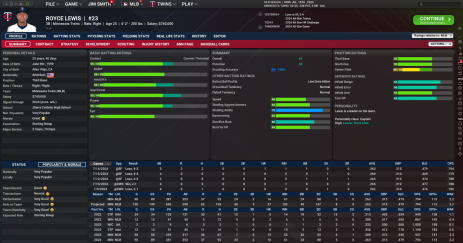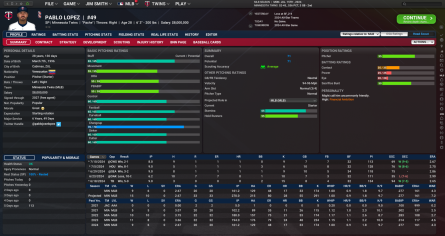Summary

On the summary page it gives some general information.
Basic Batting Ratings
For batters, like showing in the picture above, you will see a basic depiction of their ratings.
- Contact - This rating is a mixture of both BABIP and Avoid K's
- BABIP - This rating shows how good a player is at likely to put the ball in play and get more hits, with a higher batting average.
- Avoid K's - is a measure of how well a player avoids striking out. Avoid K's directly affects the number of times a player strikes out. For example, players with high Avoid K's ratings are more likely to foul off pitches with two strikes than to go down swinging.
- Gap Power - is a measure of how much power a player has to the gaps - the places in the outfield between the left fielder and center fielder, and between the center fielder and right fielder. Gap Power directly affects the number of doubles and triples a player hits. Gap Power, however, has no direct effect on home runs, or on the likelihood that a player will make contact.
- Power - directly affects the number of home runs a player hits. Power, however, has no direct effect on the likelihood that a player will make contact.
- Eye - is a measure of how well a player assesses incoming pitches and determines whether they will be balls or strikes. Eye directly affects the number of times a player walks. However, Eye has no direct effect on the likelihood that a player will make contact, or strike out.
Batter Summary & Other Battings Ratings
Under summary it will show the players ratings, depending on which settings you have set for Overall and Potential ratings under Game Settings > Global Settings. This can be in None displayed, Stars, Values of 20 to 80, or Values of 20 to 80 (Increments of 5). It will also show the current scouting accuracy.
Under Other batting Ratings the following information can be found:
- Batted Ball Profile - This the batting profile of the batter. It is based of Power and BABIP. A player with Average BABIP and Power will be considered a Normal Hitter. A player with HIGH Power but low BABIP will be listed as a Flyball Hitter and a player with HIGH BABIP will be listed as a Line Drive Hitter. Question - Can a Flyball Hitter become a Line Drive Hitter? The answer is yes. If a players BABIP improves to a high level, they can become a Line Drive Hitter and if their BABIP regresses, they could end up as a Normal or Fly Ball Hitter (depending on the players power).
- Groundball Tendency - There are four different types of groundball hitters, Normal Hitters, Spray Hitters, Pull Hitters and Extreme Pull Hitters.
- Normal - Batted balls are distributed normally, which means that the majority of balls will go to the hitter's 'pull' side. (Right-handed hitters will hit a majority of balls to the left side of the field, and left-handed hitters will hit a majority of balls to the right side of the field.)
- Spray Hitter - Batted balls are more or less equally likely to go to any part of the field.
- Pull Hitter - Batted balls are more likely to be pulled to the hitter's side. (Right-handed hitters will hit most balls to the left side of the field, and left-handed hitters will hit most balls to the right side of the field.)
- Extreme Pull Hitter - Batted balls are noticeably more likely to be pulled to the hitter's side. (Right-handed hitters will hit most balls to the left side of the field, and left-handed hitters will hit most balls to the right side of the field.)
- Flyball Tendency - Like above, there are different types of Flyball Hitters. There are three general types of Flyball Hitters.
- Normal - Batted balls are distributed normally, which means that the majority of balls will go to the hitter's 'pull' side. (Right-handed hitters will hit a majority of balls to the left side of the field, and left-handed hitters will hit a majority of balls to the right side of the field.)
- Spray Hitter - Batted balls are more or less equally likely to go to any part of the field.
- Pull Hitter -Batted balls are noticeably more likely to be pulled to the hitter's side. (Right-handed hitters will hit most balls to the left side of the field, and left-handed hitters will hit most balls to the right side of the field.)
Note: Hitter Tendency does not affect the likelihood that a player will make contact, or how much power the hitter has. It affects only the trajectory of a batted ball.
- Speed - Speed is a measure of how quickly a player can run from one base to the next. Players with a high rating in Speed are more of a threat to steal bases, and are more likely to advance further on a ball in play. Running Speed is strictly for offensive play. For example, Speed does not factor into an outfielder's range. However, Speed and Defensive Range are linked internally. For example, as a player ages, his speed and range will generally decline at the same pace.
- Stealing Aggressiveness - Stealing Aggressiveness is a measure of how aggressive a runner will be to try and steal a base.
- Stealing Ability - Stealing is a measure of how good a player is at stealing. Stealing bases is not a matter only of speed, but also timing, knowledge of pitchers, and ability to 'get a good jump.' It is possible for a player to have a high Running Speed rating, but a low Stealing Bases rating, and vice versa, although the most dangerous baserunners have high ratings in both. A combination of strategy settings for stealing bases and Running Speed is used to determine how often a runner is given a "green light" to steal a base. Speed and pitcher Hold Rating then determine how good a jump the runner gets. If he gets a good jump and goes (ie a stolen base attempt) the Catcher Arm, pitcher Hold Rating, the type of pitch and Stealing Bases rating are the factors which determine whether the runner is safe.
- Baserunning - Baserunning is a measure of a player's ability when running the bases. Players with a high rating in Baserunning are more likely to take advantage of fielder miscues to advance a base, and less likely to get thrown out due to baserunning mistakes.
- Sacrifice Bunt - Sacrifice Bunt is a measure of how well a player can execute a sacrifice bunt. Players with a high rating in Sacrifice Bunt are more likely to execute the bunt correctly, advancing the runner. They are also less likely to strike out while bunting.
- Bunt for Hit - Bunt for Hit is a measure of how well a player can execute bunt in an attempt to reach base safely. Players with a high rating in Bunt for Hit are more likely to bunt to a good location for reaching base. Players with high Running Speed and high Bunt for Hit have the best chance at bunting for a hit. Left-handed hitters are also better at bunting for a hit.
Batter Position Ratings, Defensive Ratings, and Personality
Basic Pitching Ratings
For pitchers, you will get their basic pitching ratings, including their pitches.

